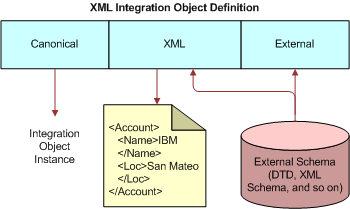Integration Objects
Integration objects are logical representations of Siebel business objects or external application data, such as externally defined XML documents. An integration object is metadata stored in the Siebel Repository. One integration object can be mapped to another integration object. Instances of integration objects are used in integration processes for data exchange. For more information on integration objects, see Integration Platform Technologies: Siebel Enterprise Application Integration.

Integration objects are made up of three distinct data sections: the canonical, the external, and the XML, as shown in the following.

The integration object schema in the Siebel Repository is composed of the three data sections shown in the following table.
| Name | Purpose |
|---|---|
Canonical section |
Stores information about an object in a common representation. The names used for objects, components, and fields are the names that the designer wishes to be visible. The data types are the Siebel business component field types that are used by the Object Manager. |
External section |
Stores information about how the object, component, or field is represented in the external system. For integration objects based on business objects, this can include the business object names, component names, and field names and data types. |
XML section |
Stores the mapping between an integration object definition and its XML representation. This allows any integration object to be represented as XML. |